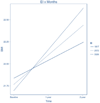Elevated objectively measured but not self-reported energy intake predicts future weight gain in adolescents
- PMID: 24930597
- PMCID: PMC4128488
- DOI: 10.1016/j.appet.2014.06.012
Elevated objectively measured but not self-reported energy intake predicts future weight gain in adolescents
Abstract
Background: Although obesity putatively occurs when individuals consume more calories than needed for metabolic needs, numerous risk factor studies have not observed significant positive relations between reported caloric intake and future weight gain, potentially because reported caloric intake is inaccurate.
Objective: The present study tested the hypothesis that objectively measured habitual energy intake, estimated with doubly labeled water, would show a stronger positive relation to future weight gain than self-reported caloric intake based on a widely used food frequency measure.
Design: Two hundred and fifty-three adolescents completed a doubly labeled water (DLW) assessment of energy intake (EI), a food frequency measure, and a resting metabolic rate (RMR) assessment at baseline, and had their body mass index (BMI) measured at baseline and at 1- and 2-year follow-ups.
Results: Controlling for baseline RMR, elevated objectively measured EI, but not self-reported habitual caloric intake, predicted increases in BMI over a 2-year follow-up. On average, participants under-reported caloric intake by 35%.
Conclusions: RESULTS provide support for the thesis that self-reported caloric intake has not predicted future weight gain because it is less accurate than objectively measured habitual caloric intake, suggesting that food frequency measures can lead to misleading findings. However, even objectively measured caloric intake showed only a moderate relation to future weight gain, implying that habitual caloric intake fluctuates over time and that it may be necessary to conduct serial assessments of habitual intake to better reflect the time-varying effects of caloric intake on weight gain.
Trial registration: ClinicalTrials.gov NCT00433680 NCT02084836.
Keywords: Caloric intake; Doubly labeled water; Prospective; Weight gain.
Copyright © 2014 Elsevier Ltd. All rights reserved.
Conflict of interest statement
The authors declare no conflicts of interest.
Figures
References
-
- Abayomi K, Gelman A, Levy M. Diagnostics for multivariate imputations. J R Stat Soc. 2008;57:273–291.
-
- Bandini LG, Schoeller DA, Dyr HN, Dietz WH. Validity of reported energy intake in obese and nonobese adolescents. Am J Clin Nutr. 1990;52:421–425. - PubMed
-
- Berkey CS, Rockett HR, Field AE, Gillman MW, Frazier AL, Camargo CA, Colditz GA. Activity, dietary intake, and weight changes in a longitudinal study of preadolescent and adolescent boys and girls. Pediatrics. 2000;105:1–9. - PubMed
-
- Black AE, Cole T. Biased over- or under-reporting is characteristic of individuals whether over time or by different assessment methods. J Am Diet Assoc. 2001;101:70–80. - PubMed
-
- Black AE, Prentice AM, Coward WA. Use of food quotients to predict respiratory quotients for the doubly-labeled water method of measuring energy-expenditure. Hum Nutr Clin Nutr. 1986;40:381–391. - PubMed
Publication types
MeSH terms
Associated data
Grants and funding
LinkOut - more resources
Full Text Sources
Other Literature Sources
Medical


